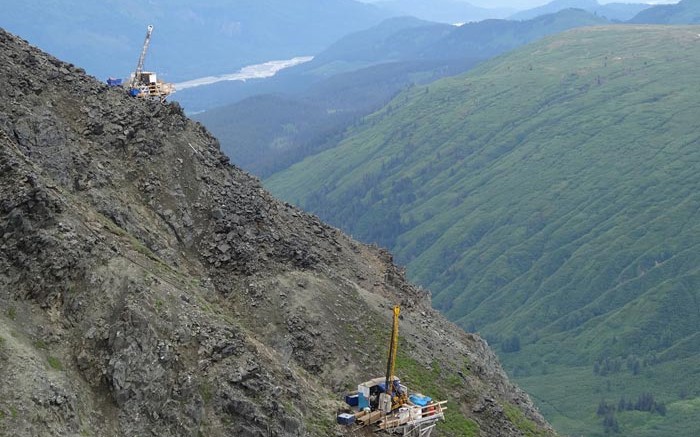VANCOUVER — The second hole of the season at Constantine Metal Resources’ (TSXV: CEM; US-OTC: CNSNF) Palmer project in southeast Alaska has returned a high-grade copper–zinc intercept from 150 metres below the defined resource, achieving one of the company’s exploration goals right off the bat.
Constantine has three drills turning at Palmer — a road-accessible property 60 km from the town and port of Haines — where steep hills host lenses of volcanogenic massive sulphide (VMS) mineralization.
In 2009, after several seasons of exploration, Constantine proved up an initial resource for Palmer totalling 4.8 million inferred tonnes grading 1.84% copper, 4.57% zinc, 0.28 gram gold per tonne and 29 grams silver per tonne. The tonnes are divided between two areas, known as RW and South Wall, which are part of the same stratigraphic interval but sit on opposing limbs of a large-scale anticline.
Recent work has focused on the South Wall area, which hosts three known lenses of mineralization. South Wall zone I contains most of the defined resource at Palmer, which is set to grow, as the resource does not include a series of high-grade intercepts from 2013 that extend zone I at depth.
In targeting those holes Constantine relied on geophysics, specifically a large conductive plate extending down from the near-surface zone I resource.
This year Constantine hoped to repeat that success. The company has worked with another set of geophysical data that established a conductive anomaly below zones II and III that looks similar to the one beneath zone I.
The first hole into the target deviated from its goal, instead cutting a few short intercepts near a hole drilled in 2010. The second hole did precisely what Constantine had in mind: it intersected a thick lens of VMS mineralization 150 metres below the defined resource at zones II and III.
Hole 54 cut 22.1 metres grading 2.48% copper, 4.05% zinc, 24 grams silver and 0.39 gram gold.
“You never totally trust geophysics, but this hole is an awesome confirmation of that modelled plate,” Constantine’s vice-president of exploration Darwin Green said. “And what’s exciting is that the zone I plate really tightly defines the copper-rich core of that massive sulphide lens and this conductive plate is larger, so by comparing them it’s pretty encouraging to think that we can develop some pretty significant tonnage at depth surrounding hole 54.”
The conductive anomaly measures 400 metres down and 400 metres across. Green says they were excited to test the area before the results from hole 54, but now the anomaly is becoming the focus of Constantine’s 10,000-metre drill program.
“We have three drills going and thought we would have two working to expand zones II and III to depth, while the third roamed around to peripheral targets,” Green said. “Now we’re putting more emphasis on this because it’s a pretty significant new development for the project, really with the potential to frame out the necessary tonnes that are needed to make this thing work.”
The mineralized lenses at Palmer are encased in steep mountains that rise up from the plains, where the road runs along the creek past the property and on to Haines. Constantine’s drills are testing the lenses from above, which is why the intercept in hole 54 started 350 metres downhole. The lenses would not, however, be mined from above, so the depth is not an impediment the way it would be in other exploration scenarios.
“Even though it’s deep, elevation-wise we’re still above creek-level, so it would still be a lateral development,” Green said. “For most projects that depth would mean it would take a long time to develop down to the mineralization, but here it would be the first stuff you would develop, with a lateral drive into the side of the hill.”
Constantine’s partner, Dowa Metals & Mining, is sole funding the US$6.2-million exploration program at Palmer this year. Dowa is earning a 49% stake in Palmer by spending US$22 million at the project over four years.
Most of the money will fund drilling but Constantine, which operates the project, is also building a 4 km access road up the mountain to the South Wall area.
The partners have completed an initial round of metallurgical test work, which returned promising results. Palmer’s mineralization responded well to conventional flotation processing: 89.6% of the copper reported to a copper concentrate, alongside 73.7% of the silver and 61.5% of the gold, while 84.9% of the zinc reported to a zinc concentrate.
“Of particular importance to the project and the company’s partner, which operates the largest zinc smelter in Japan, zinc concentrates produces from the locked-cycle tests are of good quality, with low impurities and no potential penalty or problematic elements,” Constantine said.
On news of the hole 54 intercept Constantine’s share price gained 4.5¢ to close at 18.5¢ — a 52-week high. In the last year shares have traded as low as 4¢. Constantine has 116 million shares outstanding.


Be the first to comment on "Constantine starts season at Palmer with nice hit"